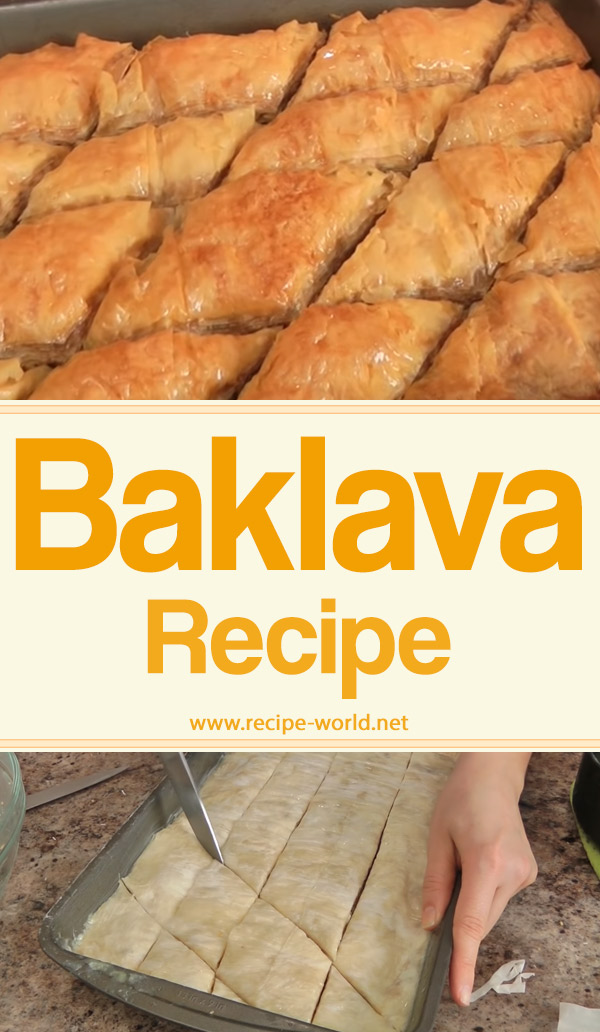Baklava is a sweet, rich Middle Eastern dessert enjoyed all over the world. It is made of layers of phyllo dough and chopped nuts, then sweetened with honey. Although the history of baklava is not well-documented, it is said that in the ancient times, the Greek sailors and merchants discovered this delicious sweet treat in Mesopotamia. They didn’t only bring baklava back home but also developed and perfected its recipe. Until the mid-19th century, baklava was considered “food for the rich” and was only baked during special occasions. Although it may seem that baklava is just a mouth-watering sweet treat, you will be surprised to know that it is also a healthy dessert. The nuts are high in unsaturated fat and are a great source of vitamin E, copper, magnesium, and folic acid. The phyllo dough is low in calories and free from trans-fat and saturated fats.
With this recipe, you’ll discover that it is so much better to make baklava at home than buying it. Assembling the many layers of phyllo dough may seem a lot of work but we’ll assure you of more than a hundred percent satisfaction with the burst of flavor and texture as you bite into the amazingly crispy, glazed exterior to the rich and dense interior.
Ingredients:
This recipe takes about 90 minutes to make. The baklava needs to be set aside for at least 6 hours or overnight. Serves 10 to 12.
• 40 9×13” sheets of phyllo dough
• 3 sticks of butter, melted
Filling:
• 4 cups of chopped walnuts
• 1 ½ tsp of cinnamon
• ½ cup of granulated sugar
• zest of 1 lemon
• zest of 1/2 orange
• ¼ tsp salt
• 4 tbsp melted butter
Syrup:
• ½ cup of granulated sugar
• ¾ cup of honey
• 1 cup of water
• 2 tsp vanilla extract
• juice of ½ lemon
Instructions:
Preheat the oven to 350°F.
Put chopped walnuts in food processor and pulse just until the walnuts are finely chopped.
Transfer the finely chopped walnuts to a large bowl.
Add cinnamon, granulated sugar, salt, lemon zest, orange zest, and melted butter.
Using a spatula, mix until everything is well combined.
Brush the bottom of a 9×13” baking sheet with melted butter.
Layer a phyllo dough, then brush the top with melted butter.
Repeat this step for another 7 layers of phyllo dough.
Evenly spread ¾ cup of the walnut filling on top of the 8th phyllo dough.
Put another 6 layers of phyllo dough while brushing melted butter in between each layer.
Brush the top of the 6th phyllo dough with melted butter, then evenly spread ¾ cup of the filling mixture on top.
Repeat these two steps for another 3 layers of phyllo dough and walnut filling.
Finally, layer 8 phyllo dough while brushing melted butter on top of every sheet.
Using a sharp knife, evenly slice the baklava into 4, lengthwise.
Then, slice diagonally to make a diamond pattern.
Bake in the oven at 350°F for 40 to 45 minutes or until golden brown on top.
While the baklava is baking in the oven, prepare the syrup.
Put granulated sugar, honey, water, vanilla extract, and lemon juice in a saucepan.
Cook over medium heat while stirring constantly for about 5 minutes or until the sugar has dissolved.
Let the syrup cool completely.
As soon as the baklava is cooked, take it out from the oven, then pour the syrup on top.
Cover the pan with a clean kitchen towel and let it sit in the counter or in the fridge for at least 6 hours or overnight before serving.
Ideas And Tips:
You can substitute melted butter with olive oil.
Aside from walnuts, you can use pistachios, pine nuts, hazelnuts or almonds.
You can also drizzle chocolate syrup on top of the baklava before serving.
As phyllo dough is very thin, it can dry up and tear easily. Make sure to cover the unused dough with a clean damp kitchen towel while assembling the baklava.
Letting the baklava sit before serving not only makes the baklava absorb the all the flavors from the syrup but also helps its layers set giving you a perfect slice of baklava, every time.

images – https://www.youtube.com/watch?v=R9dUlCgXvpQ
😳 What Tinnitus Does To Your Brain Cells (And How To Stop It)
After 47 years of studies and countless brain scans done on more than 2,400 tinnitus patients, scientists at the MIT Institute found that in a shocking 96% of cases, tinnitus was actually shrinking their brain cells.
As it turns out, tinnitus and brain health are strongly linked.
Even more interesting: The reason why top army officials are not deaf after decades of hearing machine guns, bombs going off and helicopter noises…
Is because they are using something called "the wire method", a simple protocol inspired by a classified surgery on deaf people from the 1950s...


